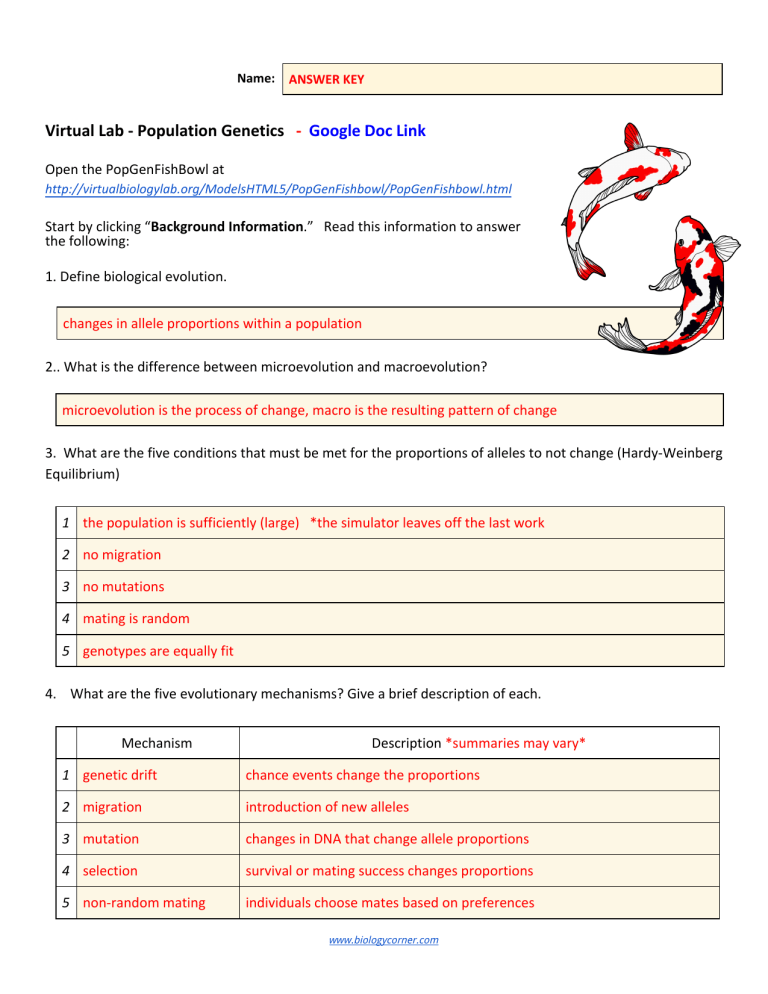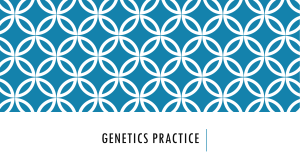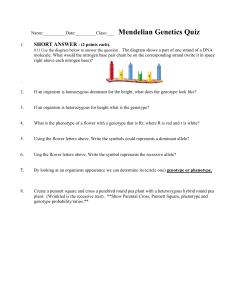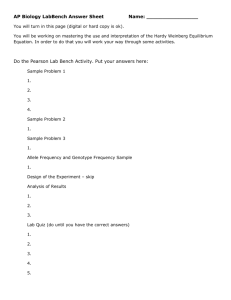
Name: ANSWER KEY Virtual Lab - Population Genetics - Google Doc Link Open the PopGenFishBowl at http://virtualbiologylab.org/ModelsHTML5/PopGenFishbowl/PopGenFishbowl.html Start by clicking “Background Information.” Read this information to answer the following: 1. Define biological evolution. changes in allele proportions within a population 2.. What is the difference between microevolution and macroevolution? microevolution is the process of change, macro is the resulting pattern of change 3. What are the five conditions that must be met for the proportions of alleles to not change (Hardy-Weinberg Equilibrium) 1 the population is sufficiently (large) *the simulator leaves off the last work 2 no migration 3 no mutations 4 mating is random 5 genotypes are equally fit 4. What are the five evolutionary mechanisms? Give a brief description of each. Mechanism Description *summaries may vary* 1 genetic drift chance events change the proportions 2 migration introduction of new alleles 3 mutation changes in DNA that change allele proportions 4 selection survival or mating success changes proportions 5 non-random mating individuals choose mates based on preferences www.biologycorner.com 5. What are some examples of selective breeding? cereal crops, broccoli, wolves (dogs) 6. What are the three varieties of koi? solid red solid white mottled (red and white) Part 1: Population in Hardy-Weinberg Equilibrium Click the Home icon to go back to the main menu and click on “Run Experiments”. First, we will work with the default parameters. This default population is in Hardy-Weinberg equilibrium. 7. Before switching over to the data collection tab, calculate the following variables. The frequency of the dominant allele (p) = 0.5 and the recessive alle (q) = .5 (p + q = 1) Frequency of homozygous dominant genotype (RR) Frequency of heterozygous genotype (Rr) Frequency of homozygous recessive genotype (rr) = www.biologycorner.com p2 = .25 2pq = .50 q2 = .25 8. Click “To Data” and compare your genotype predictions to the frequencies in the model. Allow the simulation to run for 100 generations (press the fast forward button to speed up the simulation and you can also pause it). *answers may vary, but should be close to HQ equilibrium Frequency of dominant allele (R) = .43 Frequency of recessive allele (r) = .57 Frequency of homozygous recessive genotype (rr) = .32 Frequency of heterozygous genotype (Rr) = .5 Frequency of homozygous dominant genotype (RR) = .18 9. Reset the simulation by hitting the blue reset button in the top right. Return to the design page, and now change the initial ‘R’ Allele proportion to 0.3. Calculate the following (see HW Equation): Frequency of dominant allele (R) p= .3 Frequency of recessive allele (r) q= .7 Frequency of homozygous recessive genotype (rr) q2 = .49 Frequency of heterozygous genotype (Rr) 2pq = .42 Frequency of homozygous recessive genotype (RR) = p2 = .09 10. Run the simulation through 100 generations. What are the frequencies now? *answers may vary Frequency of dominant allele (R) p= .25 Frequency of recessive allele (r) q= .75 Frequency of homozygous recessive genotype (rr) q2 = .55 Frequency of heterozygous genotype (Rr) 2pq = .4 Frequency of homozygous dominant genotype (RR) = q2 = .05 11. Is this population in Hardy Weinberg Equilibrium? How do you know? This is not at equilibrium, the proportion of R alleles is much lower. 12. Will this population ever reach equilibrium? Why or why not? Alleles are just reshuffled through each generation, the low starting R allele will stay low. www.biologycorner.com Part 2: Selection and Fitness Relative Fitness is the survival rate of a genotype (or phenotype) relative to the maximum survival and/or reproductive rate of other genotypes in the population. It is a number between 0 and 1. Investigation 1: Selection for Spotted You will investigate a scenario where the spotted phenotype is advantageous because koi fish with a spotted pattern are less likely to be seen by predators.Set your simulation to the following parameters: Carrying capacity: 200 Initial ‘R’ Allele Prop: 0.5 Relative genotype fitness of rr: 0.7 Relative genotype fitness of RR: 0.7 Click the reset button to begin data collection. 13. Allow the simulation to run for at least 100 generations, and then record your data in the table below: Proportion of rr Genotype after 100 generations .31 Proportion of Rr Genotype after 100 generations .54 Proportion of RR Genotype after 100 generations .16 14. What is meant by “FITNESS” in this scenario? the ability to survive Investigation 2: Selection Against White Now, you’ll investigate a scenario where selection is against a particular phenotype (in this case, perhaps the white phenotype is disadvantageous because those fish are easily seen by predators). Set your simulation to the following parameters: Relative genotype fitness of rr: 0.3 Relative genotype fitness of Rr: 1 Relative genotype fitness of RR: 1 15. Click the reset button to begin data collection. Allow the simulation to run for at least 100 generations, and then record your data in the table below: *answers may vary Proportion of rr Genotype after 100 generations .03 Proportion of Rr Genotype after 100 generations .32 Proportion of RR Genotype after 100 generations .66 www.biologycorner.com 16. We reasonably expect there to be no white fish because of the selection, but the frequency of r may not be zero, even if there are no white fish. Why not? The allele exists in the population and can be passed down to the next generation. 17. It is likely that there were sometimes no white fish for a period, but then a few returned a few generations later. What might cause this? the allele exists in the population, if two heterozygous parents got together, 25% of offspring is white 18. In population genetics, fixation is the change in a gene pool from a situation where there exists at least two variants of a particular gene (allele) in a given population to a situation where only one of the alleles remains. The gene has become “fixed.” Describe how this might happen in the koi population. If a random event killed all the individuals that had the r allele, then it would be eliminated from the population. Also possible that it could be eliminated due to mate preference, but only if heterozygous were selected against. 19. Summarize the effect of natural selection on the evolution of populations. Use the term “fitness” in your explanation. Answers vary. Natural selection can change the frequency of alleles in the population. Organisms with the greatest fitness are more likely to survive and pass their alleles to the next generation. 20. The simulator also allows you to adjust “assortative mating.” Change the strength of this parameter to 1 and run some simulations. Describe what happens and propose a definition for assortative mating. In the simulations I ran, most of the fish became orange and the frequency of the r allele dropped to near zero. Students might propose that assortative mating refers to some kind of mate choice of preference. www.biologycorner.com Name: Virtual Lab - Population Genetics in a Fishbowl Open the PopGenFishBowl at http://virtualbiologylab.org/ModelsHTML5/PopGenFishbowl/PopGenFishbowl.html Start by clicking “Background Information.” Read this information to answer the following: 1. Define biological evolution. 2.. What is the difference between microevolution and macroevolution? 3. What are the five conditions that must be met for the proportions of alleles to not change (Hardy-Weinberg Equilibrium) 1 2 3 4 5 4. What are the five evolutionary mechanisms? Give a brief description of each. Mechanism Description 1 2 3 4 5 www.biologycorner.com 5. What are some examples of selective breeding? 6. What are the three varieties of koi? Part 1: Population in Hardy-Weinberg Equilibrium Click the Home icon to go back to the main menu and click on “Run Experiments”. First, we will work with the default parameters. This default population is in Hardy-Weinberg equilibrium. 7. Before switching over to the data collection tab, calculate the following variables. The frequency of the dominant allele (p) = 0.5 and the recessive alle (q) = .5 (p + q = 1) Frequency of homozygous dominant genotype (RR) Frequency of heterozygous genotype (Rr) Frequency of homozygous recessive genotype (rr) = www.biologycorner.com p2 = 2pq = q2 = 8. Click “To Data” and compare your genotype predictions to the frequencies in the model. Allow the simulation to run for 100 generations (press the fast forward button to speed up the simulation and you can also pause it). What are the frequencies? Frequency of dominant allele (R) = Frequency of recessive allele (r) = Frequency of homozygous recessive genotype (rr) = Frequency of heterozygous genotype (Rr) = Frequency of homozygous dominant genotype (RR) = 9. Reset the simulation by hitting the blue reset button in the top right. Return to the design page, and now change the initial ‘R’ Allele proportion to 0.3. Calculate the following (see HW Equation): Frequency of dominant allele (R) p= Frequency of recessive allele (r) q= Frequency of homozygous recessive genotype (rr) q2 = Frequency of heterozygous genotype (Rr) 2pq = Frequency of homozygous recessive genotype (RR) = p2 = 10. Run the simulation through 100 generations. What are the frequencies now? Frequency of dominant allele (R) p= Frequency of recessive allele (r) q= Frequency of homozygous recessive genotype (rr) q2 = Frequency of heterozygous genotype (Rr) 2pq = Frequency of homozygous dominant genotype (RR) = q2 = 11. Is this population in Hardy Weinberg Equilibrium? How do you know? 12. Will this population ever reach equilibrium? Why or why not? www.biologycorner.com Explain these results. Part 2: Selection and Fitness Relative Fitness is the survival rate of a genotype (or phenotype) relative to the maximum survival and/or reproductive rate of other genotypes in the population. It is a number between 0 and 1. Investigation 1: Selection for Spotted You will investigate a scenario where the spotted phenotype is advantageous because koi fish with a spotted pattern are less likely to be seen by predators.Set your simulation to the following parameters: Carrying capacity: 200 Initial ‘R’ Allele Prop: 0.5 Relative genotype fitness of rr: 0.7 Relative genotype fitness of RR: 0.7 Click the reset button to begin data collection. 13. Allow the simulation to run for at least 100 generations, and then record your data in the table below: Proportion of rr Genotype after 100 generations Proportion of Rr Genotype after 100 generations Proportion of RR Genotype after 100 generations 14. What is meant by “FITNESS” in this scenario? Investigation 2: Selection Against White Now, you’ll investigate a scenario where selection is against a particular phenotype (in this case, perhaps the white phenotype is disadvantageous because those fish are easily seen by predators). Set your simulation to the following parameters: Relative genotype fitness of rr: 0.3 Relative genotype fitness of Rr: 1 Relative genotype fitness of RR: 1 15. Click the reset button to begin data collection. Allow the simulation to run for at least 100 generations, and then record your data in the table below: Proportion of rr Genotype after 100 generations Proportion of Rr Genotype after 100 generations Proportion of RR Genotype after 100 generations www.biologycorner.com 16. We reasonably expect there to be no white fish because of the selection, but the frequency of r may not be zero, even if there are no white fish. Why not? 17. It is likely that there were sometimes no white fish for a period, but then a few returned a few generations later. What might cause this? 18. In population genetics, fixation is the change in a gene pool from a situation where there exists at least two variants of a particular gene (allele) in a given population to a situation where only one of the alleles remains. The gene has become “fixed.” Describe how this might happen in the koi population. 19. Summarize the effect of natural selection on the evolution of populations. Use the term “fitness” in your explanation. 20. The simulator also allows you to adjust “assortative mating.” Change the strength of this parameter to 1 and run some simulations. Describe what happens and propose a definition for assortative mating. www.biologycorner.com




